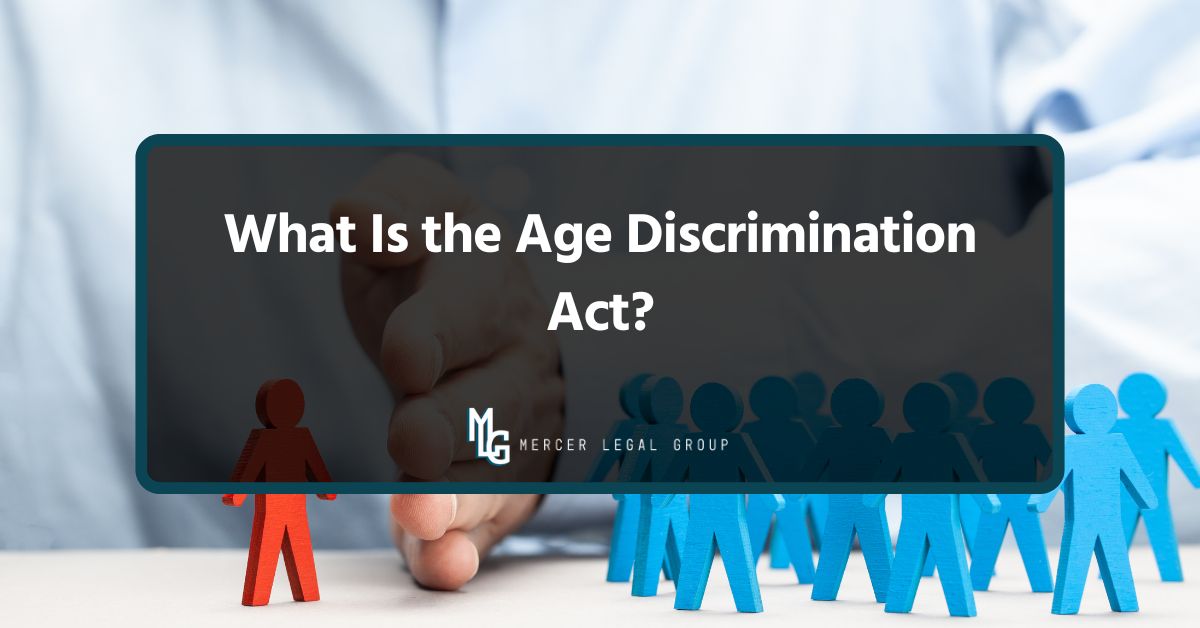Age discrimination in many industries impacts employees’ careers and overall well-being. The Age Discrimination in Employment Act (ADEA) is a U.S. federal law that protects employees 40 and older from workplace discrimination based on age. The protections in the Age Discrimination Act ensure older employees have equal opportunities in hiring, promotions, assignments, pay, and job security.
At Mercer Legal Group, our experienced age discrimination attorneys help employees facing age discrimination understand their rights under the Age Discrimination Act. With a strong track record in California, we have successfully secured settlements and protections for countless clients. We provide knowledgeable, compassionate guidance through every step of the legal process, ensuring your concerns are heard and addressed. Contact us today for a free consultation and take action to protect your career and future.
This blog will explain what the Age Discrimination Act is, how it protects employees from age-based bias, and what steps you can take if you experience age discrimination at work.
What Is Age Discrimination?

Age discrimination occurs when an employee or job applicant is treated unfairly because of their age. This can happen through biased hiring practices, unjust work appraisals, or unfair promotions and demotions. They can affect individuals of any age, although they disproportionately impact older workers, typically those aged 40 years or older.
Federal workplace regulations prohibit discrimination across the United States. The California laws against age discrimination and the federal Age Discrimination in Employment Act (ADEA) provide the main legal protections. These California labor laws prohibit employers from age-based hiring.
How Does Age Discrimination Look?
Age discrimination can appear in many areas of the workplace, affecting employees’ opportunities and career growth. One common example is unfair hiring practices, where employers favor younger candidates over qualified applicants who are 40 or older, even when the older candidates have equal or greater experience. Such bias can prevent talented, experienced workers from advancing or even being considered for positions they are fully capable of performing.
Older workers may also not get paid fairly, and they may get lower salaries, fewer raises, or smaller bonuses than younger coworkers who do the same job. Employers might assign them less desirable or menial tasks based on assumptions about their abilities rather than actual performance. In some cases, older workers are wrongfully demoted or pressured into early retirement, which undermines their career stability and professional growth.
Harassment and retaliation are other forms of age discrimination. Age-based jokes, negative comments, or insulting statements, such as “You’re too old to handle this role” or “We need someone younger,” can create a hostile or intimidating work environment. Retaliation, such as demoting, punishing, or even terminating employees who report discrimination or file complaints, discourages them from defending their rights.
Employment Age Discrimination Act (ADEA)
In addition to state-level safeguards, the ADEA protects workers 40 and older. The California laws against age discrimination forbid discrimination in hiring, firing, promotions, compensation, and other employment circumstances for firms with 20 or more employees.
Unlike California Employment Law, the ADEA offers similar safeguards but applies to larger employers and processes claims differently. The federal Equal Employment Opportunity Commission (EEOC) enforces the ADEA, while California’s age discrimination employment laws handle complaints from the California Fair Employment and Housing Act (FEHA).
The ADEA also protects employees principally engaged in industries such as higher education, public service employment, and other sectors under federal jurisdiction. It covers employment practices across both private organizations and federal entities, including workers in positions within a federal department or those seeking opportunities through an employment agency. The law addresses not only overt discrimination but also unfair treatment like unequal access to training, benefits, or job assignments based on age.
The act provides clear procedures for employees to file complaints with the EEOC and seek remedies, all in line with the ADEA’s goal of eliminating age-based bias. By working alongside state-level laws like FEHA, the ADEA creates a comprehensive framework that protects older employees across both private organizations and large corporations, ensuring fair treatment and equal opportunities for workers in all covered sectors.
What Is the Age Discrimination Act?

The Age Discrimination in Employment Act (ADEA) is a federal law that protects employees and job applicants aged 40 and older from unfair treatment in the workplace. It ensures that age cannot be a factor in hiring, promotions, compensation, work assignments, or termination decisions. While the ADEA is the most widely known, several other federal and state laws also exist to safeguard workers against age-based discrimination.
The California Fair Employment Discrimination and Housing Act (FEHA)
The California Fair Employment and Housing Act (FEHA) prohibits age discrimination across the state and identifies target groups it protects, describing intended beneficiaries as individuals who are 40 years old or older. FEHA establishes criteria for fair treatment and prohibits employers from making decisions based on certain age distinctions.
The law applies to all private and public sector employers with five or more employees, including local governments, and governs employment across various sectors, such as human services, vocational education, and postsecondary institutions. It also ensures that employees in these fields are evaluated fairly and protected from decisions based solely on age.
FEHA strictly forbids age-based discrimination in any employment practice, including hiring, firing, promotions, layoffs, and work assignments, unless decisions are based on reasonable factors apart from age. Employees must be evaluated on their qualifications, skills, and performance rather than their age, ensuring fair treatment across all job-related decisions. This ensures that age alone cannot determine career opportunities or advancement for workers in both the public and private sectors.
The law also protects workers from harassment based on age. Harassment can include jokes, comments, or actions that create a hostile, threatening, or insulting workplace environment for members of protected target groups. FEHA guarantees that employees can perform their duties in a safe and respectful environment, free from age-related mistreatment.
FEHA safeguards employees who report or complain about age discrimination, prohibiting any retaliation by employers. Individuals cannot be fired, demoted, or punished for exercising their legal rights under the law. This protection encourages employees to speak up without fear, reinforcing fair employment practices for all workers, regardless of certain age distinctions.
Additionally, FEHA works alongside federal regulations to ensure comprehensive protection for older employees. By covering a wide range of sectors, including human services, vocational education, postsecondary institutions, and local government, the law ensures that employees across all industries have equal opportunities to advance, receive fair treatment, and work in environments free from age-related bias.
Older Workers Benefit Protection Act (OWBPA)
The Older Workers Benefit Protection Act (OWBPA) is a federal law designed to safeguard the benefits of employees aged 40 and older. Enacted as an amendment to the Age Discrimination in Employment Act (ADEA), the OWBPA ensures that employers cannot reduce, deny, or otherwise discriminate against older employees in terms of employee benefits, such as health insurance, retirement plans, or severance packages. This law plays a crucial role in protecting the financial security and well-being of older workers while reinforcing the principle of fair treatment in the workplace.
One of the most important parts of the OWBPA is that employers must provide clear and specific information when they offer waivers of age discrimination claims, especially in severance agreements or early retirement packages. The act requires that any waiver be knowing and voluntary, meaning the employee must have sufficient time to consider the agreement, be informed of their rights, and receive independent advice if desired. Employers must also ensure that benefit plans do not discriminate against older workers, and any differences in benefits must be justified by factors apart from age.
The OWBPA also applies to organizations that receive federal financial assistance or extended federal financial assistance, including programs administered through health and human services. Employers failing to comply with the act risk having funds withheld or facing legal action to enforce equitable treatment for older employees.
Employers must carefully review benefit plans and agreements to make sure that older workers are treated fairly and that any waivers meet the strict legal standards set by the OWBPA. For employees, the law provides important protections, giving them the confidence to assert their rights without fear of losing benefits or being forced into unfair agreements. Overall, the OWBPA strengthens protections for older employees, promotes transparency in employment practices, and helps create a workplace environment where experience and seniority are respected rather than penalized.
Civil Rights Act (Title VII)
The Civil Rights Act of 1964, specifically Title VII, primarily prohibits employment discrimination based on race, color, religion, sex, or national origin. While Title VII does not directly cover age, it is indirectly related to age discrimination because certain workplace practices that violate protections under the Age Discrimination in Employment Act (ADEA) can overlap with other forms of prohibited discrimination. For instance, older employees who belong to another protected group may face combined or compounded discrimination, making Title VII relevant in certain cases where age and another protected characteristic intersect.
Employers must ensure that their hiring policies follow both Title VII and the ADEA. This is especially important when they are judging employees in target groups that include older workers who may also be part of racial, gender, or religious minority groups. Title VII reinforces the principle that employment decisions, such as hiring, promotions, compensation, and termination, must be based on qualifications and performance rather than stereotypes, including certain age distinctions that could disadvantage older employees. Many organizations implement training programs and policy audits to align practices with both laws, reducing the risk of discrimination claims.
Understanding the interplay between Title VII and the Age Discrimination Act is important for both employers and employees. For employers, it ensures compliance with federal civil rights protections and encourages voluntary compliance in creating fair, merit-based workplaces.
For employees, this overlap provides additional avenues to challenge unfair treatment and ensures protections extend beyond age alone. Together, these laws help maintain a respectful and inclusive work environment where employees of all ages and backgrounds, including younger workers, can thrive while safeguarding their rights under federal law.
How Do Federal and State Age Discrimination Laws Work Together?
Federal and state laws work in tandem to protect employees from age discrimination in the workplace. The Age Discrimination in Employment Act (ADEA) sets minimum protections for workers aged 40 and older across the United States, covering key employment practices such as hiring, promotions, compensation, and termination.
Federal regulations provide a baseline, while state laws, like California’s Fair Employment and Housing Act (FEHA), often offer stronger or broader safeguards, ensuring employees have comprehensive protection against unfair treatment. State laws complement federal statutes by addressing additional circumstances and industries that may not fall under federal jurisdiction.
For example, FEHA covers smaller employers with five or more employees, whereas the ADEA typically applies to firms with 20 or more employees. State laws may also extend protections to employees in local government, human services, vocational education, and postsecondary institutions, providing a wider net of coverage for older workers. Together, federal and state frameworks establish clear legal standards and enforcement procedures to promote equitable treatment across industries.
By working together, federal and state laws ensure that employees can seek remedies through multiple avenues. Individuals may file complaints with the Equal Employment Opportunity Commission (EEOC) under the ADEA or with state agencies, such as the California Department of Fair Employment and Housing (DFEH), under FEHA.
This dual system reinforces the commitment to eradicate age discrimination, while offering support, protection from retaliation, and various remedies such as job reinstatement, back pay, or coverage of attorney’s fees. Ultimately, the collaboration between federal and state laws creates a robust framework that empowers employees to challenge discrimination and encourages employers to maintain fair, merit-based employment practices.
What Are Employers’ Obligations Under the Age Discrimination Act?

Under the Age Discrimination in Employment Act (ADEA), employers are required to protect employees’ civil rights by treating all workers and job applicants fairly, particularly those aged 40 and older. This duty covers all parts of a job, such as hiring, promotions, training, pay, work assignments, and firing. Employers must avoid decisions based on certain age distinctions and establish criteria focusing on skills, qualifications, and job performance.
These regulations apply to all employers, whether they are private organizations, sole proprietorships, or entire corporations, and extend to any program or activity receiving federal assistance. Fair, merit-based practices benefit both older employees and younger workers, promoting equity and inclusion in the workplace.
Employers must also maintain a work environment free from age harassment and retaliation. Harassment, such as jokes, comments, or intimidating behavior targeting older employees (target groups), is prohibited. Organizations should implement clear policies, train staff and managers, and address complaints promptly.
Retaliation against those reporting age discrimination or participating in investigations is strictly forbidden. Such practices undermine workplace integrity and violate both federal and state employment laws. Many employers follow voluntary compliance programs to demonstrate solid faith in protecting employee rights and fostering a safe, respectful workplace.
Proactive review of employment practices is essential. Hiring procedures, promotions, performance evaluations, and retirement policies should not disadvantage older workers. Clear documentation, consistent policy application, and ongoing training ensure adherence to the regulations prescribed by the ADEA. These measures reduce legal risks and create a fair, inclusive workplace where employees of all ages can thrive.
Employer Best Practices to Avoid Age Discrimination
Employers can take steps to stop age discrimination and ensure they follow federal and state laws. Establishing clear policies that prohibit discrimination and harassment is critical, and these policies should cover all employees, including those in a state or local government or local educational agency. Policies should define what constitutes age discrimination and guide reporting procedures, helping employees understand their rights and the administrative remedies available if issues arise.
Training managers and supervisors is essential to promote fair treatment and prevent bias in hiring, promotions, compensation, and other employment decisions. Regular training should address the employment act amendments, highlighting changes or updates to federal and state age discrimination laws. Employers should also monitor workplace practices during normal operation to ensure that older employees are evaluated based on qualifications, skills, and performance rather than assumptions or stereotypes about age.
Maintaining documentation and consistent processes helps protect both employees and employers. When an employee reports discrimination, organizations should investigate thoroughly and respond appropriately, even if the complaint involves the same alleged violation as a prior case. Proper documentation supports administrative remedies and demonstrates the employer’s commitment to compliance with anti-discrimination laws. Keeping clear records also makes sure that decisions about hiring, promotions, performance reviews, and firing are open and honest.
Finally, employers should foster an inclusive workplace culture that values experience and diversity across all age groups. Encouraging open communication, providing mentorship opportunities, and promoting fair access to training and advancement help reduce age bias. By following these best practices, organizations not only comply with legal requirements but also create a supportive environment where employees of all ages can thrive, minimizing the risk of claims under the Age Discrimination in Employment Act and related laws.
What Should You Do if You Experience Age Discrimination?
If you suspect age discrimination, it’s important to be aware of your rights and take proactive steps to protect yourself. Start by carefully documenting everything, including dates, times, individuals involved, emails, memoranda, and witness statements. Detailed records are essential, as complaints or lawsuits rely heavily on documented evidence to support your claims, and a person aggrieved may be entitled to reasonable attorney’s fees if the case proceeds to court.
Next, consider filing a complaint with the appropriate authorities. You can submit a complaint to the California Department of Fair Employment and Housing (DFEH) or the federal Equal Employment Opportunity Commission (EEOC). Both agencies investigate age discrimination claims and provide technical assistance to help individuals navigate the process. In some cases, matters may be taken to the United States District Court if formal legal action is necessary to hold employers accountable.
Additionally, seek legal advice from an attorney specializing in age discrimination, particularly if you’re unsure whether your situation qualifies or need guidance through the legal process. Advocating for yourself is also crucial. Report workplace harassment or discriminatory behavior promptly. Taking these steps demonstrates that you understand your rights and are committed to ensuring fair treatment, which can strengthen your case, prevent further discrimination, and help secure remedies under the law.
What Are Employees’ Rights When Facing Age Discrimination?

Employees facing age discrimination have the right to be treated fairly and without bias based on their age. Under federal laws like the Age Discrimination in Employment Act (ADEA), a federal statute authorizing protections for workers 40 and older, and state laws such as California’s Fair Employment and Housing Act (FEHA), employees are shielded from unfair treatment in hiring, promotions, compensation, work assignments, and terminations. These laws ensure that employment decisions are based on qualifications, skills, and performance rather than age-related stereotypes.
Workers also have the right to a workplace free from age-based harassment or retaliation. Harassment can include offensive jokes, comments, or actions that create a hostile work environment, while retaliation may involve demotion, termination, or other punitive measures against employees who report discrimination.
Employees can file complaints with the Equal Employment Opportunity Commission (EEOC), state agencies such as the California Department of Fair Employment and Housing (DFEH), or, in the case of serious disputes, take matters to federal court. Written documentation of any alleged violation or incident, including a written report, is crucial for establishing a strong case.
Additionally, employees have the right to seek guidance and representation from legal professionals experienced in age discrimination cases, as well as support from a labor organization when applicable. They can document incidents, collect evidence, and pursue claims while ensuring that employers comply with established enforcement procedures. Protections also cover remedies other than attorney’s fees, which gives someone who has been wronged the confidence to stand up for their rights and demand fair treatment.
These rights empower workers to advocate for themselves, prevent further discrimination, and access remedies that uphold career opportunities, workplace dignity, and equitable treatment across all employment practices. By understanding and exercising these rights, employees can take proactive steps to protect themselves and ensure that their workplace remains fair and inclusive.
Need Help Against Discrimination at Work?
Age discrimination can seriously impact an employee’s career and opportunities. The Age Discrimination in Employment Act (ADEA), along with federal regulations and California’s Fair Employment and Housing Act (FEHA), provides strong protections for workers over 40 and ensures they are treated fairly in hiring, promotions, compensation, and workplace assignments. These laws enable older employees to thrive without facing bias and offer them clear avenues to address unfair treatment.
Have you experienced age discrimination at work? At Mercer Legal Group, our experienced employment attorneys in California specialize in cases under the Age Discrimination Act (ADEA), helping employees understand and assert their rights. With a proven track record of securing fair outcomes, we provide expert guidance and personalized support every step of the way. Contact us today for a free consultation and take the first step toward protecting your career and achieving justice.
Frequently Asked Questions
Age discrimination can affect employees at any stage of their career; they should understand their rights under the Age Discrimination in Employment Act (ADEA). This FAQ section provides answers to common questions about age discrimination, including how to recognize it and the steps you can take to protect yourself.
What Are the Signs That Someone Is Being Discriminated Against Because of Their Age?
Signs of age discrimination can include being consistently passed over for promotions, training, or challenging assignments in favor of younger colleagues, or receiving negative remarks about one’s age or being told they are “too old” for certain roles. Other indicators include sudden exclusion from workplace activities, unjustified performance criticism, or pressure to retire early.
What Is Considered Evidence of Age Discrimination?
Evidence of age discrimination can include emails, performance reviews, or company policies that demonstrate biased treatment based on age, as well as witness statements or patterns indicating that younger employees are favored for promotions and opportunities. Documentation of demotions, termination, or negative comments tied explicitly to age also strengthens a discrimination claim.
How to Win an Age Discrimination Case?
To win an age discrimination case, you need to show clear evidence that your age was a factor in adverse employment actions, such as being passed over, demoted, or terminated, and that similarly situated younger employees were treated more favorably. Supporting documentation, witness testimony, and demonstrating that the employer’s stated reasons are inconsistent or pretextual can significantly strengthen your case.




